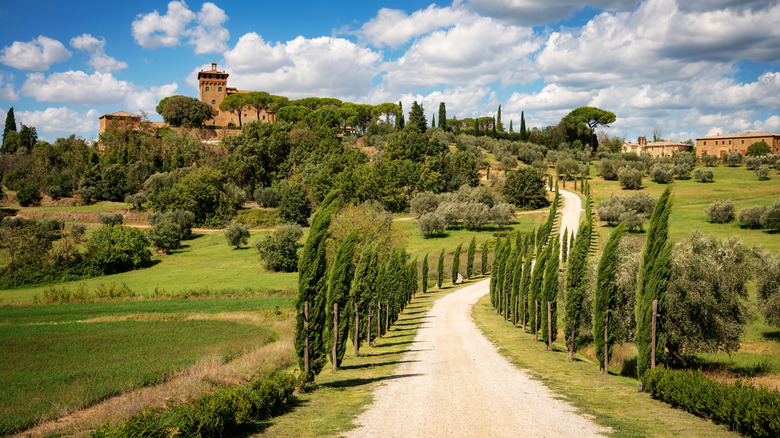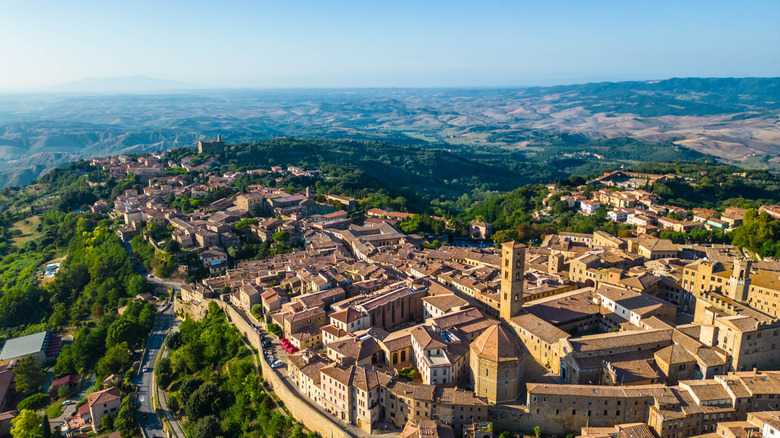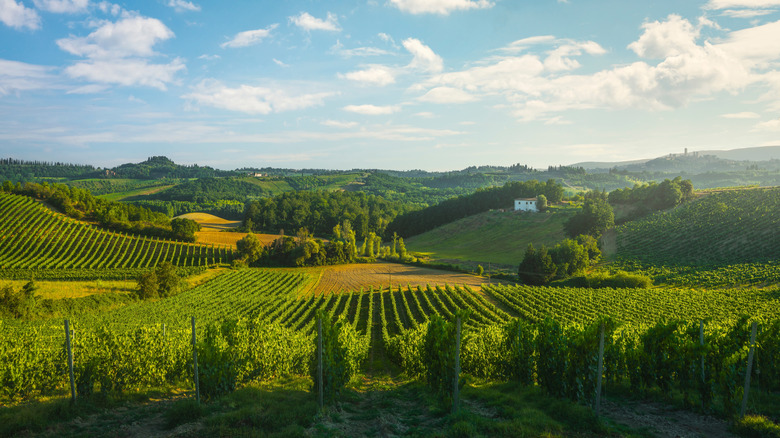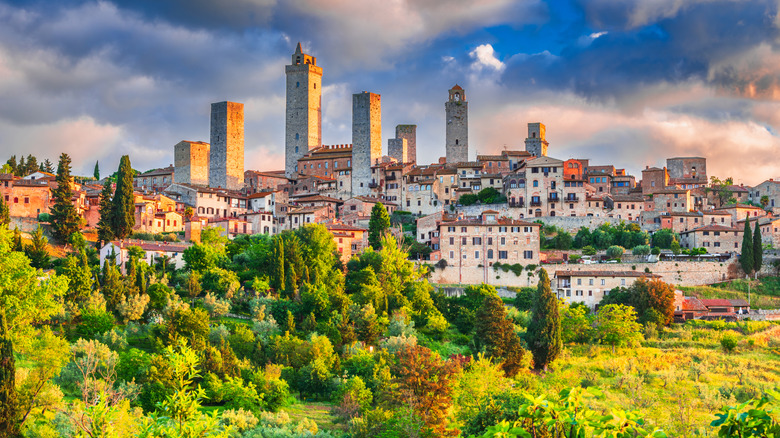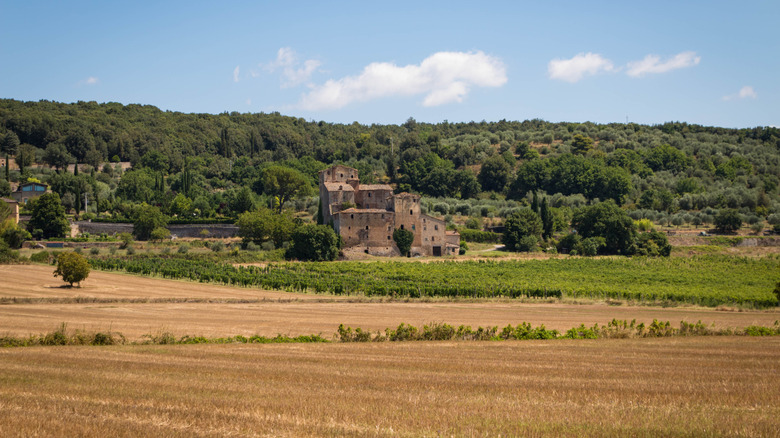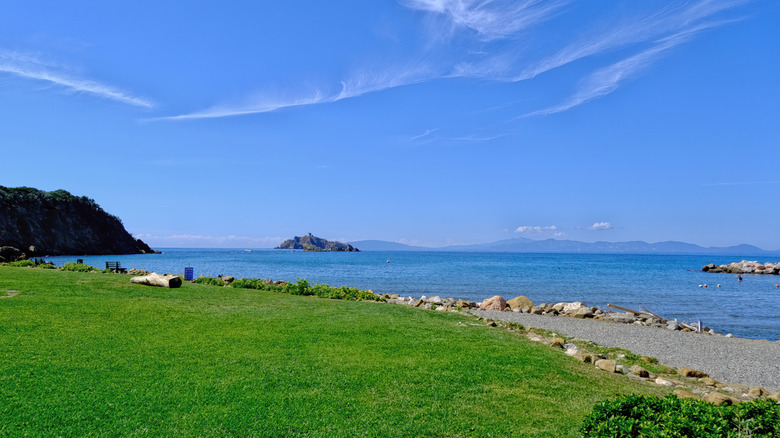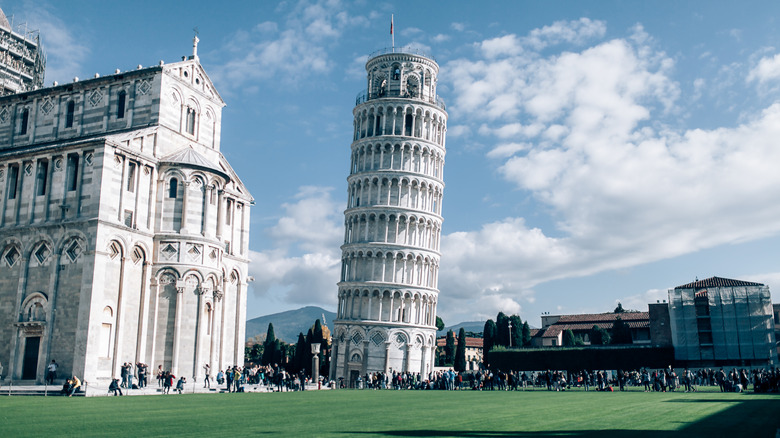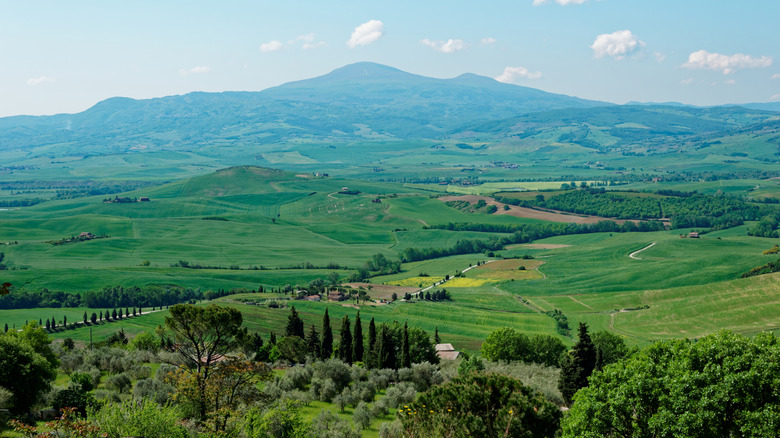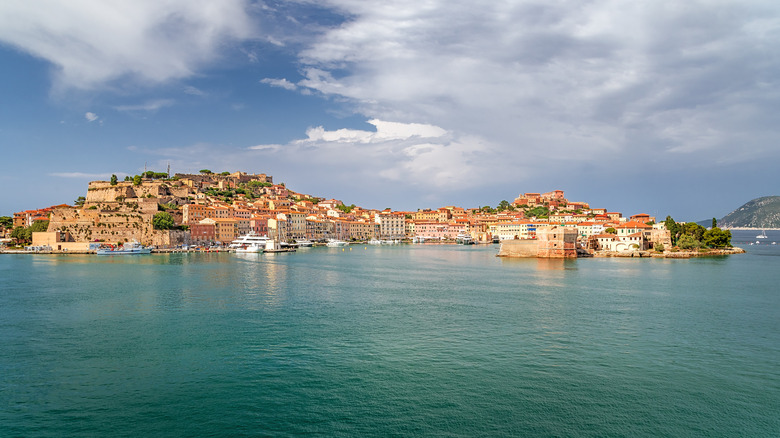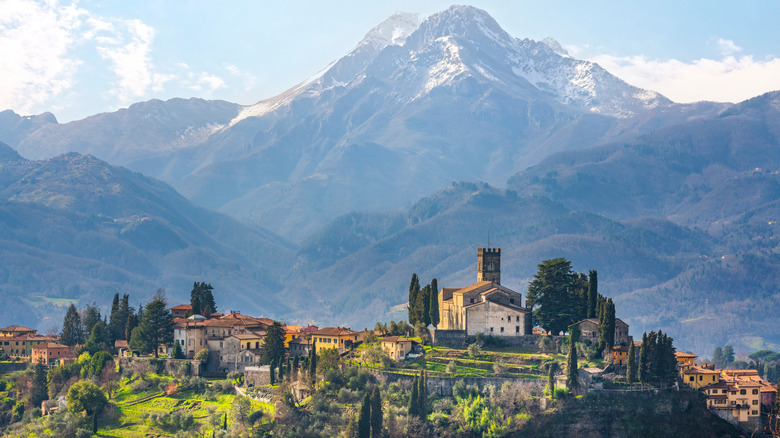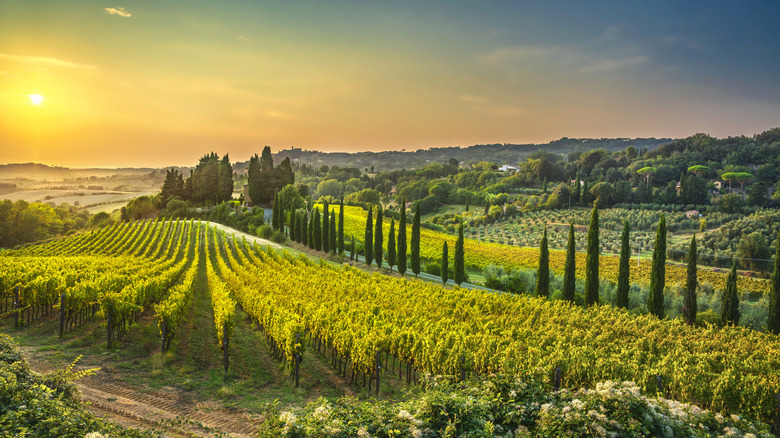The Most Breathtaking Camping Destinations In Tuscany, Italy, According To A Veteran Camper
Europe's vast, forested interiors are fringed with so many bargain-priced pitches that it's hard to know where to begin. Its Mediterranean underbelly is dotted with caravan parks. Its Atlantic coast is filled with campsites nestled in hidden coves. In 2023, some 91 million people decided to spend some of their precious vacation time trying to get back to nature. Such travelers went far and wide in search of the perfect spot to pitch their tent. Sure, those parts of Europe known for their fickle weather saw fewer bookings, and, yes, the risk-averse chose France over Sweden. But the truly aware stayed consistent. They headed to Tuscany.
The central Italian province is littered with must-see spots. It possesses no fewer than seven UNESCO World Heritage sites, and is so topographically diverse that it offers something for every kind of camping style. To its east, you will find Florence and the stark beauty of the Accona Desert. Travel north and you'll enter a world of alpine forests and sweeping mountain views that add a timbre to your glamping life backdrop.
To the west lies Tuscany's coast and campsites offering beach sports and swimming. Those venturing south soon find themselves in a land of rolling hills, untamed olive groves, and thermal springs. Hikers roam over them by day, returning to the cool refuge of their forested campsite as the sun sets. The climate is varied, but summers are mild, and even on those days when the temperature tops 100 degrees Fahrenheit, Tuscany remains an excellent place to camp. Lush forests proliferate right up to the coast. The best campsites take advantage of such shade, ocean proximity, or a combination of the two to create a camping experience with few peers.
Le Balze
Volterra is, perhaps, less well-known than some of Tuscany's other cities, but it is no less magnificent for it. A walled city of medieval vintage, its central plaza retains its original frescoes, while its well-preserved bell tower offers glorious views of the surrounding lands. Less than 9 miles from the picturesque Brignone Nature Reserve, the town is also home to the Badia di San Giusto, a stunning 11th-century monastery. The region is steeped in Etruscan history, and visitors are treated to museums dedicated to fine art, alabaster sculptures, and the remains of a Roman amphitheater.
Against this backdrop sits the camping site of Le Balze. The camp takes its name from the Balze Natural Area — a region of towering cliffs and ravines some 38 miles distant. The Italian hill town of San Gimignano is only a 40-minute drive from the campground, while Florence itself is less than 50 miles away. Facilities on offer include a swimming pool, which is open during the summer months; a small bar can be found a few yards away. There is also a barbecue area kitted out with picnic tables and grill stations, electricity for every pitch, and free Wi-Fi thrown in for good measure. Prices start as low as $23.39, and a large pitch able to accommodate six people can be reserved for under $70.
Panorama del Chianti
The Chianti region is an area of rolling hills sandwiched between Florence and Siena. The Florentines defined these boundaries in the 14th century. Later, in 1716, Grand Duke Cosimo III de Medici codified laws governing the production of wine. Such strict rules are still followed to this very day. Chianti remains a must-visit wine destination for those traveling through Italy, but the region has much more to offer than the archetypical wine tasting tour. The landscape is peppered with vineyards, yes, but there are also olive groves to admire, wild forests of chestnut and holm, and medieval towns to explore. The hills roll on to the horizon, offering glimpses of ancient villas, cypress-lined lanes, and the cobbled streets of half-forgotten towns.
The Panorama del Chianti, tucked away in a quiet corner less than 20 miles south of Florence, offers all this and more. It also sits within driving distance of San Gimignano, a walled town that dates back to Biblical times. The campsite itself acts as a jumping-off point to a myriad of ventures. Paths wind their way through the hills, taking prospective hikers past castles, villages, and vineyards. The much-beloved city of Volterra is only an hour's drive away. Meanwhile, cookery classes abound and are an excellent introduction to the local cuisine.
Pitches are situated in natural shade, and the site offers electrical hookups and on-site Wi-Fi. There is a laundry area, shared fridge and freezer amenities, and, as you'd expect, toilet and shower facilities. The pool is open from mid-May to October and features a bar, which serves breakfast, lunch, and fresh bread daily. To top it all, it offers a Vesta rental service and a glamping village for those who prefer to add a dash of class to their stay.
Boschetto Di Piemma
Those wishing to get even more up close and personal with San Gimignano would do well to visit the campsite of Il Boschetto Di Piemma. Its position — just under 3 miles from the city and its magnificent towers — makes for a fairy tale backdrop. Similarly, the surrounding area is a place of laconic beauty. Oak trees and fragrant vegetation envelop the site, which is also a stone's throw from one of Italy's most famous routes.
The Via Francigena begins not in Italy but in Canterbury, England. The route dates to the 10th century, when it began as a pilgrimage made by itinerant priests looking to present themselves to the pope. Passing through France and Switzerland, the trail moves south through the Chianti region en route to its final destination, Rome and the Holy See.
The campsite facilities will serve those looking to take a break from the nearly 2,000-mile trek. There is an on-site restaurant serving wood-fired pizza, a pool, tennis courts, and a solarium-come-bar service to enjoy. Soccer and beach volleyball facilities are also available for those who prefer larger team games. Meanwhile, Wi-Fi coverage is robust, and a combination of traditional pitches and rentable mobile homes rounds off the experience quite nicely.
La Montagnola
There are many topographical features worth mentioning in Southern Tuscany. Chief amongst them surely has to be the Montagnola Hills. The highest peak, Montemaggio, at just over 2,200 feet, dominates the region, although most other gradients consist of far gentler slopes. The region is heavily wooded with dense canopies that provide shelter from the summer sun. The undergrowth below is fragrant with juniper, honeysuckle, and wild strawberries.
The La Montagnola campsite lies in a peaceful corner of the territory, surrounded by villages, hidden trails, castles, and monasteries. The village of Malignano sits less than 2 miles to the south. It has a population of just 21 people. It's worth exploring, though those who do so will not be alone. Hikers battle their way through the hills and forests with pugilistic fervor. Siena is only 15 miles to the north, and the quaint village of Serravalle is less than a mile distant. It is a region of summer retreats; indeed, some of the oldest villas you can stay at in Italy can be found right here.
Visitors to the camp can find a pitch for less than $11 with access to free electricity and hot showers. Caravan rentals are a little more expensive — clocking in at close to $60 per night — yet still represent good value all things considered. The views are, after all, something to write home about. The medieval commune of Sovicille is just a stone's throw away, and there, you will find restaurants, a bank, and other modern conveniences. Few places offer a feeling of quiet isolation while still maintaining links to the modern world.
Punt Ala Camp & Resort
The rolling hills and perfumed fields of central Tuscany are matched only by the delicately composed beauty of its Tyrrhenian coast. The 204-mile stretch begins at the Marina di Carrara and continues south past hidden Italian beaches that offer secluded escapes. Somewhere around the halfway line, just over 7 miles from Grosseto — the capital of Maremma and former pirate-raid alumni — lies Punta Ala. The campsite is a tale of two environs. The original pitches were all situated well within 15 acres of crisp, Mediterranean pine forest. The site, a former hunting reserve owned by successive Grand Dukes of Tuscany, still forms the core of the experience. Over the years, however, the resort has more than quadrupled in size. A recent pivot toward an eco-friendly experience has further differentiated the place.
While the pine trees continue to provide shade, the sea offers respite from even the most sweltering summer days. The beach is only some feet away, and the resort comes pre-loaded with amenities and activities aplenty. There are two restaurants to choose from, tennis courts to reserve, and trail bikes to rent. Additional facilities are also first rate — modern personal hygiene stations mix company with wash and dry facilities and a beachside CrossFit center. As a bonus, boats can be taken out free of charge.
The focus on nurturing nature is taken seriously here. No open flames are allowed; the use of plastic implements is frowned upon. Meanwhile, any waste produced is expected to be differentiated, collected, and ultimately recycled. Rules that might feel jarring initially melt away upon first glimpse of the camping ground. The whole region presents itself without so much as a blemish. Whether gazing out to sea or resting on softly tended grass, there is nothing to distract the eye from the all-encompassing splendor laid out before it.
Camping Village Torre Pendente
There are a number of ways to explore Italy on a shoestring budget, and camping within walking distance of famous landmarks is certainly one of them. Torre Pendente sits sandwiched between two such sights. To its east, less than 1 mile distant, rests the city of Pisa's famously wonky tower. To its west, the urban sprawl gives way to San Rossore Park, a veritable paradise of sand dunes, pine forests, and marshland. Where one is a teeming metropolis steeped in cultural heritage, the other is a place of wild boar, fallow deer, walking trails, and beaches. It makes for a delicious contrast.
The idea of a camping ground deep in the heart of a major city might sound a little strange to some, but here, at least, the concept works. The leaning tower may well only be a few minutes walk away, but the sheltered nature of the camping village insulates guests from the hustle of city living. Each pitch comes with its own electricity supply while also providing the shaded greenery so essential to campers battling the Etruscan summer.
The village proper also has a variety of static homes to choose from, with larger spaces offering a money-saving kitchenette and up to three bedrooms. There's an on-site restaurant and bar to sample — although proximity to the city center broadens such choices immensely — and a minimarket that provides for all your camping needs. The swimming pool stays open from May to September and comes replete with its own jacuzzi. It even stays open for moonlight swims on occasion.
Agriturismo Val Della Pieve
The concept of agritourism might be new to some, but in Val Della Pieve, situated only 1,640 feet from the charming village of Anghiari, it's a way of life, and an instructive one at that. Vacationing close to the center of food production does, after all, help visitors reconnect with the natural rhythms of the planet. Still, there are many reasons to consider a farm stay when planning a getaway. Few places emphasize that point better than Val Della Pieve.
Tent pitches are located on a raised terrace to maximize views of the stunning Val Sovara. Olive groves surround the region, interspersed with forested areas, and the campsite edges up against a small lake on one side. Here, guests are encouraged to fish for carp and eel. In summer, the pool and jacuzzi open. During the winter months, a sitting room with a fireplace is available to those seeking respite from the cold. The optional farmhouse breakfast is a thing of homemade cake and jam with a selection of local meats and cheeses thrown in for good measure. Served with hot drinks and biscotti, it's robust enough to keep you going through any morning hike you venture out on.
Meanwhile, Anghiari caters to all the guests' other needs. It is, as you'd expect with a Tuscan village, a hill town of medieval vintage and a particularly beautiful one at that. Award-winning in its own right, municipal highlights include its imposing Bastione stronghold, with its still-intact 13th-century walls and deep historical significance. The town overflows with small, independent stores, and its centuries-old connection to crafts makes it a souvenir hunter's dream.
Le Esperidi
The Tuscan coast had long found itself harried by pirates sailing from North Africa, but starting in the 16th century, the raids picked up pace. Galleys sailing from what was then referred to as the Barbary Coast would attack merchant ships, sign contracts with enemy powers, and raid coastal settlements at will. In 1785, a frustrated Duke of Tuscany ordered the construction of a defensive structure to act as a patrol point to help protect his coast. Forte di Bibbona, as it was called, still stands, and as the pirate threat retreated into the shadows of modernity, the marina that grew around it began to draw in crowds.
The camping village of Le Esperidi is situated less than 2 miles from the fort. As with Punta Ala, the mix of nearby pine forests, aromatic Mediterranean scrub, and fine white beaches makes it perfect for prospective campers. Now in its fifth decade of existence, the campsite feels almost like a synthesis of everything great about spending time on the Etruscan coast. Some 400 pitches are available for tents, motorhomes, and caravans. Such spaces, however, are no mere patches of grass. Instead, visitors are treated to sheltered groves of local pine and holm trees.
The shade and sense of privacy are appreciated year-round. There are numerous restaurants and bars available for guests, including one situated on a terrace overlooking the sea. An ice cream kiosk helps cool people down, a shop filled with local produce reduces cost, and you can even have wood-fired pizza delivered directly to your tent. There's an eclectic array of sports facilities on offer, fitness classes to attend, and a wellness village to luxuriate in. Hikers are well-served by the region, and the nearby Macchia Della Magona Woodland Reserve is perfect for mountain bike adventures.
Valle Santa Maria
Elba is the largest island in the Tuscan archipelago and the third largest in Italy after Sicily and Sardinia. It has miles of forest, lush coastlines, and mountainous terrain, including 91 miles of rugged coastline. Its famous iron-rich black beaches hint at its antediluvian past. The ancient Greeks named the island Aethalia, or smoky place, due to the constant smelting that once took place. Those looking for the kind of breathtaking secret Italian beaches Sardinia is known for needn't worry, there are plenty of those to go around also.
Napoleon Bonaparte was exiled here in 1814, and although his stay was brief, both of his principal residences survive to this day. Its largest town, Portoferraio, is a place of Medici fortifications, international festivals, and cuisine influenced by the Barbary pirates of old. There are also archaic hilltop villages to explore. Marciana, situated approximately 10 miles from Portoferraio, dates back to 35 BCE. Meanwhile, Montecristo — a dark smudge of an island that appears to float in the clouds — is tantalizingly close. A sail by is allowed, but fewer than 1,000 people are permitted to make landfall in a year.
Little wonder then that the 21,000 square meter campsite of Valle Santa Maria is so popular. Situated less than two-thirds of a mile from the sleepy village of Lacona, the resort has been operating since 1968. Family-owned, it pairs the twin aspects of Tuscany's coastline (shaded woodland and beaches) with consummate ease. Sports facilities, laundry, and Wi-Fi complement easy beach access. A small train runs through the campsite at least once a day, providing a welcome distraction for children, and the pet-friendly policy is a welcome bonus. Meanwhile, a pitch can be reserved for less than $20, although glamping tents can cost 10 times that amount.
La Piella Lucca
The headline cities of the Tuscan region — Pisa, Florence, and Siena — often act as a distraction to further exploration. Lucca is a province, and a fairytale wonderland to boot, but it is also a capital city of some repute. In recent years, tourists have begun flocking to this lesser-known city, but the surrounding region offers much to prospective campers.
La Piella is another campsite that focuses on Tuscany's burgeoning agritourism industry. Located in a forested area some 31 miles from the capital, close to the magnificent walled city of Castiglione di Garfagnana, the camp has a lot to offer. There is, for example, the option for a little farmhouse hospitality with rentable rooms that feature real, honest-to-goodness bathrooms. To those who think that might be cheating, pitches resting in the shade of centuries-old chestnut trees bring a more traditional flavor to proceedings. Meanwhile, the shop stocks fruits picked at high altitudes, bakes bread daily, and offers a selection of freshly sourced mushrooms for guests to do with as they will.
How we curated this list
Tuscany was the holiday destination of choice for my family when I was young, and camping was always seen to keep costs down while also allowing us to reconnect with nature. Where sites on this list have not benefited from a personal visit, we've checked reviews and other aggregate lists to ensure they all meet our very high standards of excellence.
